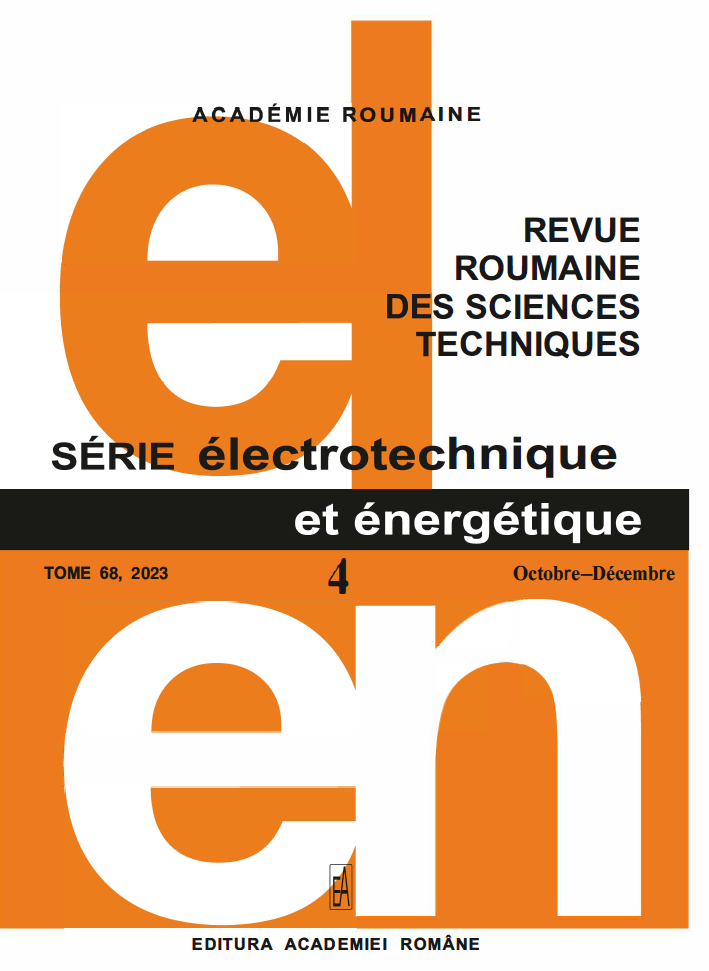DEVELOPMENT OF METHANE CARBON ISOTOPE BASED ON MID-INFRARED ABSORPTION SPECTRUM TECHNOLOGY APPLIED IN LOGGING PLATFORM
DOI:
https://doi.org/10.59277/RRST-EE.2023.4.16Keywords:
Offshore drilling platform, Methane isotope, Mid-infrared tunable semiconductor absorption spectroscopy (TDLAS), Integral separated proportional-integral-derivative (PID) control method, High precision temperature control systemAbstract
To meet the requirements of rapid measurement of oil and gas methane isotopes in offshore logging platforms, a methane carbon isotope measurement system based on mid-infrared TDLAS technology was proposed in this paper. The measuring system adopted a mid-infrared compact-linear optical structure, including an interband cascade laser (central wavelength at 2963.25 cm-1), long optical path multi-pass cell (effective optical path is 24 m) and mercury cadmium telluride detector (response wavelength is from 2 μm to 5 μm). Combining two 13CH4/12CH4 absorption lines, 2963.25 cm-1 and 2963.34 cm-1, with a high precision temperature control system using an integral separation PID control method, a temperature fluctuation within 100 mK can be achieved. In the experiment, CH4 gases with five different concentrations were configured to calibrate the measurement system, and the response linearity was more than 99%. When the integration time is 121s, the precision of isotope measurement was as low as 0.83 ‰. The average isotopic abundance of methane gas measured by the system was -10.2 ‰, and the error fluctuation was about ±0.5 ‰. It was verified that the system can rapidly measure oil and gas methane isotopes.
References
(1) J. Dai, Significant of the study on carbon isotopes of alkane gases, Natural Gas Industry, 31, 12, pp. 1–6 (2011)
(2) D. Li, X. Guo, D. Wang, P.B. Ma et al. Laser detection of oil-gas diffusion in central drain pipe of floating-roof tank, Infrared and Laser Engineering, 42, 5, p. 913 (2021).
(3) Z.Z. Wang, Technical progress and developing trends in unconventional oil and gas mud logging in China, Petroleum Drilling Techniques, 45, 6, pp. 1–7 (2017).
(4) S.B. Hammerschmidt, T. Wiersberg, V.B. Heuer et al. Real-time drilling mud gas monitoring for qualitative evaluation of hydrocarbon gas composition during deep sea drilling in the Nankai Trough Kumano basin, Geochemical Transactions, 15, pp. 1–15 (2014).
(5) Q. Niu, Y.Y. Qu, X.H. Ci, W.Z. Zhou, H.X. Zhang, Development status and prospect of carbon isotope logging technology, Logging Engineering, 30, 3, pp. 8–15 (2019).
(6) Q. Ren, C. Chen, Y. Wang et al. A prototype of ppbv-level midinfrared CO2 sensor for potential application in deep-Sea natural gas hydrate exploration, IEEE Transactions on Instrumentation and Measurement, 69, 9, pp. 7200–7208 (2020).
(7) S. Schaeffer, J. Miller, B. Vaughn et al. Long-term field performance of a tunable diode laser absorption spectrometer for analysis of carbon isotopes of CO2 in forest air, Atmospheric Chemistry and Physics, 8, pp. 5263–5277 (2008).
(8) L.S. Rothman, I.E. Gordon, Y. Babikov, et al. The HITRAN 2012 molecular spectroscopic database, Journal of Quantitative Spectroscopy & Radiative Transfer, 130, pp. 4–50 (2013).
(9) K. Jian, S.X. Liu, Y.L. Chen, X.H. Fu, Infrared spectroscopic study on the structure evolution of low-rank coal and its correlation with carbon isotope of alkane gas in pyrolysis process, Spectroscopy and Spectral Analysis, 38, 7, pp. 2070 (2018).
(10) M.L. Cong, L. Li, Y.S. Cui, Z.Q. Zhang, Y.D. Wang, Design of high stability digital control driving system for semiconductor laser, Optics and Precision Engineering, 18, 7, pp. 1629–1636 (2010).
(11) K.J. Åström, T. Hägglund, Revisiting the Ziegler–Nichols step response method for PID control, Journal of Process Control, 14, 635–650 (2004).
(12) C. Chen, W.N. Robert, Y.D Wang, A trace methane gas sensor using mid-infrared quantum cascaded laser at 7.5 μm, Applied Physics B: Lasers and Optics, 113, 4, pp. 491–501 (2013).
(13) B.W. Wang, X.D. Xu, Y.U. Wu, Oil-gas origin and accumulation characteristics of Wenchang Depression, Western Pearl River Mouth Basin, Natural Gas Geoscience, 31, 7, pp. 980–992 (2020).
(14) Y.Z. Zhang, X.D. Xu, L. You, Genesis of the natural gas in tight condensate gas reservoirs and forming model, Wenchang a sag of Pearl River Mouth Basin, Natural Gas Geoscience, 25, 9, pp. 1320–1328 (2014).
Downloads
Published
Issue
Section
License
Copyright (c) 2023 REVUE ROUMAINE DES SCIENCES TECHNIQUES — SÉRIE ÉLECTROTECHNIQUE ET ÉNERGÉTIQUE

This work is licensed under a Creative Commons Attribution-NonCommercial-NoDerivatives 4.0 International License.


